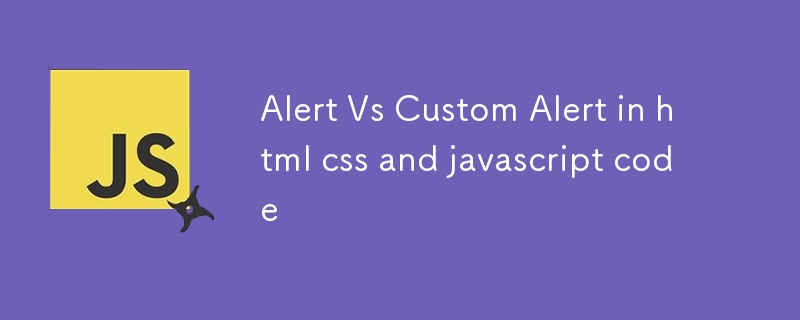

<!DOCTYPE html>
<html lang="en">
<head>
<meta charset="UTF-8">
<meta name="viewport" content="width=device-width, initial-scale=1.0">
<title>Custom Alert Box</title>
<link rel="stylesheet" href="style.css">
</head>
<body>
<div class="button-container">
<!-- Button to Trigger Default Alert -->
<button class="btn default-alert-btn">Default Alert</button>
<!-- Button to Trigger Custom Alert -->
<button class="btn custom-alert-btn">Custom Alert</button>
</div>
<!-- Custom Alert Box -->
<div class="custom-alert" id="customAlert">
<h1>Warning</h1>
<span class="alert-text">This is a custom alert with a close
option and animated border!</span>
<button class="close-btn">×</button>
</div>
<script src="script.js"></script>
</body>
</html>
/* Reset */
* {
box-sizing: border-box;
}
body {
margin: 0;
display: flex;
justify-content: center;
align-items: center;
height: 100vh;
background-color: #1a1a1a;
font-family: Arial, sans-serif;
color: #fff;
}
/* Button Styling */
.button-container {
display: flex;
gap: 20px;
}
.btn {
padding: 10px 20px;
font-size: 16px;
border: none;
border-radius: 5px;
cursor: pointer;
transition: transform 0.2s;
}
.default-alert-btn {
background-color: #4285f4;
color: white;
}
.custom-alert-btn {
background-color: #ff5722;
color: white;
}
.btn:hover {
transform: scale(1.05);
}
.custom-alert {
position: fixed;
top: 50px;
/* left: 50%; */
width: 400px;
padding: 5px;
background-color: #333;
color: #fff;
border-radius: 10px;
display: none;
opacity: 0;
transform: translateX(-50%);
animation: fadeIn 0.5s forwards;
/* Animated border effect */
border: 1px solid transparent;
border-radius: 10px;
background-image: linear-gradient(#333, #333),
linear-gradient(45deg, #ff5722, #4285f4, #0f9d58, #f4b400);
background-origin: border-box;
background-clip: content-box, border-box;
box-shadow: 0px 0px 2px rgba(255, 255, 255, 0.1);
}
/* Multicolored border animation */
@keyframes borderAnimation {
0% {
background-position: 0% 50%;
}
100% {
background-position: 100% 50%;
}
}
.custom-alert {
animation: fadeIn 0.5s forwards, borderAnimation 3s linear infinite;
background-size: 200% 200%;
}
/* Fade-in animation */
@keyframes fadeIn {
from {
opacity: 0;
transform: translateY(-20px);
}
to {
opacity: 1;
transform: translateY(0);
}
}
.alert-text {
display: inline;
}
.close-btn {
position: absolute;
top: 4px;
right: 4px;
background: none;
border: none;
color: #fff;
font-size: 30px;
cursor: pointer;
line-height: 1;
transition: color 0.2s;
}
.close-btn:hover {
color: #ff5722;
}
// Buttons
const defaultAlertBtn = document.querySelector('.default-alert-btn');
const customAlertBtn = document.querySelector('.custom-alert-btn');
const customAlert = document.getElementById('customAlert');
const closeBtn = document.querySelector('.close-btn');
// Show Default Alert
defaultAlertBtn.addEventListener('click', () => {
alert("This is the default alert.");
});
// Show Custom Alert
customAlertBtn.addEventListener('click', () => {
customAlert.style.display = 'block';
setTimeout(() => {
customAlert.style.opacity = '1';
}, 10); // Delay for CSS fade-in effect
});
// Close Custom Alert
closeBtn.addEventListener('click', () => {
customAlert.style.opacity = '0';
setTimeout(() => {
customAlert.style.display = 'none';
}, 500); // Delay for CSS fade-out effect
});
The above is the detailed content of Alert Vs Custom Alert in html css and javascript code. For more information, please follow other related articles on the PHP Chinese website!
 mysql engine introduction
mysql engine introduction
 How to solve the problem that the msxml6.dll file is missing
How to solve the problem that the msxml6.dll file is missing
 Windows 10 activation key list
Windows 10 activation key list
 What does data encryption storage include?
What does data encryption storage include?
 A complete list of alter commands in Mysql
A complete list of alter commands in Mysql
 How to close the window opened by window.open
How to close the window opened by window.open
 iexplore.exe
iexplore.exe
 What should I do if the itinerary card cannot be opened?
What should I do if the itinerary card cannot be opened?




